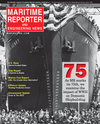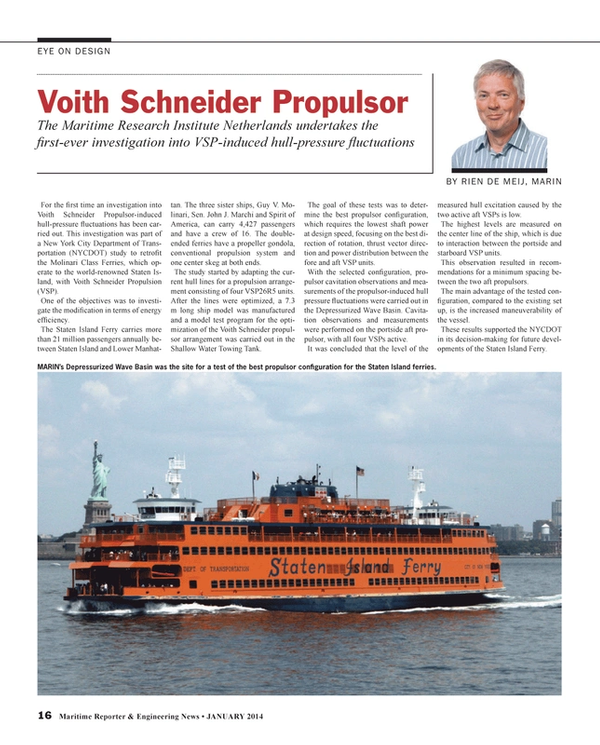
Examining Hull Pressure on the Staten Island Ferries
For the first time an investigation into Voith Schneider Propulsor-induced hull-pressure fluctuations has been carried out. This investigation was part of a New York City Department of Transportation (NYCDOT) study to retrofit the Molinari Class Ferries, which operate to the world-renowned Staten Island, with Voith Schneider Propulsion (VSP).
One of the objectives was to investigate the modification in terms of energy efficiency.
The Staten Island Ferry carries more than 21 million passengers annually between Staten Island and Lower Manhattan. The three sister ships, Guy V. Molinari, Sen. John J. Marchi and Spirit of America, can carry 4,427 passengers and have a crew of 16. The double-ended ferries have a propeller gondola, conventional propulsion system and one center skeg at both ends.
The study started by adapting the current hull lines for a propulsion arrangement consisting of four VSP26R5 units. After the lines were optimized, a 7.3 m long ship model was manufactured and a model test program for the optimization of the Voith Schneider propulsor arrangement was carried out in the Shallow Water Towing Tank.
The goal of these tests was to determine the best propulsor configuration, which requires the lowest shaft power at design speed, focusing on the best direction of rotation, thrust vector direction and power distribution between the fore and aft VSP units.
With the selected configuration, propulsor cavitation observations and measurements of the propulsor-induced hull pressure fluctuations were carried out in the Depressurized Wave Basin. Cavitation observations and measurements were performed on the portside aft propulsor, with all four VSPs active.
It was concluded that the level of the measured hull excitation caused by the two active aft VSPs is low.
The highest levels are measured on the center line of the ship, which is due to interaction between the portside and starboard VSP units.
This observation resulted in recommendations for a minimum spacing between the two aft propulsors.
The main advantage of the tested configuration, compared to the existing set up, is the increased maneuverability of the vessel.
These results supported the NYCDOT in its decision-making for future developments of the Staten Island Ferry.
(As published in the January 2014 edition of Maritime Reporter & Engineering News - www.marinelink.com)
Read Examining Hull Pressure on the Staten Island Ferries in Pdf, Flash or Html5 edition of January 2014 Maritime Reporter
Other stories from January 2014 issue
Content
- Happy Birthday to Us! page: 6
- Where is Floating Production Headed? page: 12
- Examining Hull Pressure on the Staten Island Ferries page: 16
- Submarine Motion Monitored with CFD Software page: 18
- An Examination of USCG Sonar Expansion page: 20
- Mobile's Maritime Renaissance page: 22
- ASRY's Nils Kristian Berge Talks Strategy and Investment page: 24
- Synergies Foster Shipyards Success page: 26
- Multi-mission, Dual Design, Single Focus Littoral Combat Ships page: 28
- Ugly Ducklings & Steaming the Way to Victory in WWII page: 32
- LNG is a Crystal Clear Alternative page: 40
- Drillship Profile: Tungsten Explorer page: 46
- Bravante’s New PSV is First of Five page: 47
- Cameroon Navy Takes Two Patrol Boats page: 49
- Rexroth Debuts New Control System page: 50
- HT900s for High Speed Crew Boat page: 50
- New Cummins Tier 4 Diesel Engines page: 51
- New LNG/Diesel MicroTurbines page: 51
- Castrol Launches Cyltech CL 100 page: 54
- Total Debuts Talusia Universal 100 page: 54
- CLASSNK Safety Guidelines for Gas Fuelled Ships page: 54
- Klüberbio Lubricants Meet EPA Standards page: 54
- Wärtsilä Provides LNG Package for New Ferry page: 54
- Wärtsilä Performs Exhaust Gas Clean Retrofit page: 54
- New Marine Cylinder Oil Launched page: 54
- Successful MX-Scrubber Testing page: 55
- ValvTect BioGuard Plus 6 page: 55
- Clean Marine EGCS for VLGCs page: 55
- Nano Fuels Combustion Catalyst Improves Efficiency page: 55
- Schottel Opens Two New Facilities page: 55
- Bosch Emission Systems: Cleaner and Greener page: 55
- New Hägglunds CBM Hydraulic Motor page: 55
- New ECDIS-E from Northrop Grumman page: 56
- FleetWeather Offers New Service page: 56
- AWT Provides Fleet Decision Support page: 56
- MATRIX AIS/GPS GX2200 Launched page: 56
- SI-TEX Debuts New GPS Compass page: 56
- New Tool for EPA Compliance page: 56
- Resolve Installs New Engine Room Simulator page: 56
- Jeppesen Simplifies Routing, Chart Management page: 57
- Kongsberg's Latest DP Simulator DNV Approved page: 57
- Phoenix Launches Improved LED Floodlight page: 57
- Lowrance Launches Fishfinder and Chartplotter page: 57
- NightRunner Camera System Launched page: 57
- Comark 15-in. HMI Completes Testing page: 57
- Great Lakes Shipyard Commissions New Cutting Machine page: 57
- Tanker Gets Kappel Propeller Retrofit page: 58
- Halyard Extends Noise Insulation Range page: 58
- Six Thrusters Launched from Thrustmaster page: 58
- MTU to Power Singapore’s New Naval Fleet page: 58
- Pushbutton Propulsion Order Telegraph page: 58
- Twin Disc Propulsion Packages to ADSB page: 58


